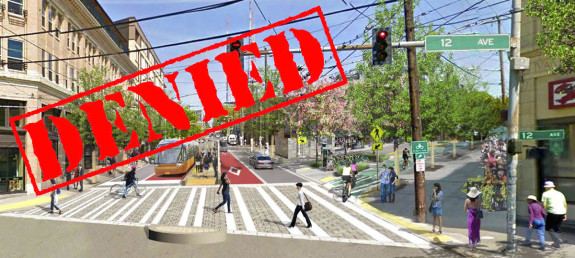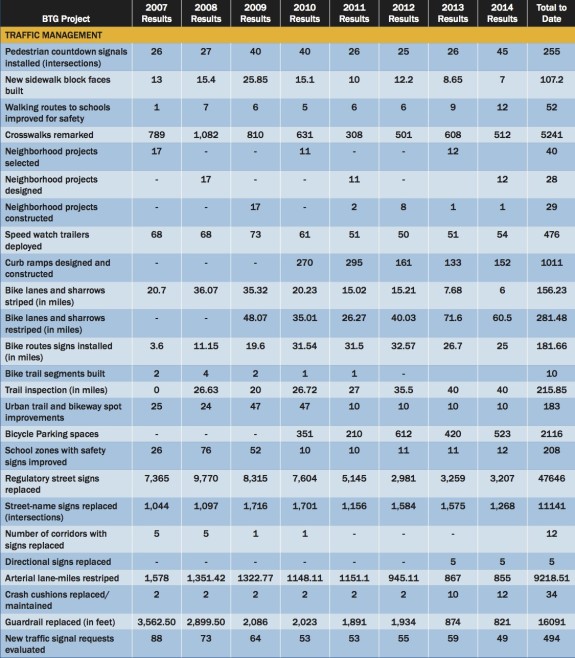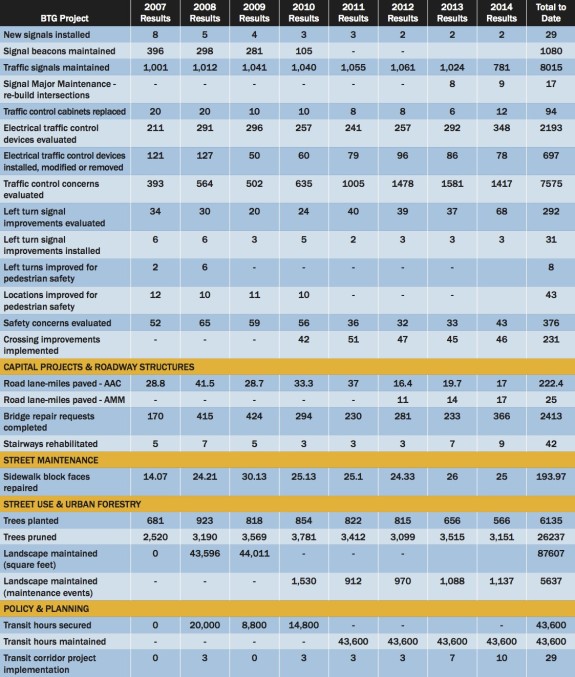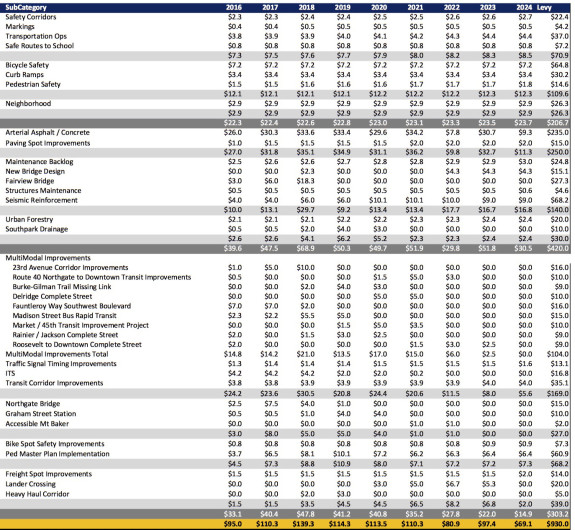
In the lead up to next week’s vote, the Let’s Move Seattle campaign has been focused on the exciting and new elements of the nine-year transportation levy proposal: Seven new rapid bus lines to all parts of town, Safe Routes to School projects at every single public school, up to 250 blocks of new sidewalks and replacing our city’s final timber-supported bridge on Fairview Ave N before an earthquake takes it down for us.
The expanded levy will also grow exciting work to provide more transportation options for everyone, like dramatically expanding the city’s ability to implement transit-efficiency projects, connecting our scattered bicycle route network, replacing old street corners with ADA accessible curb ramps and much more.
As we wrote recently, the brilliance of Move Seattle is that it makes thousands of relatively small investments that add up to create a multimodal city. It doesn’t rely on questionable megaprojects like Bertha or even the massive remake of Mercer Street. Instead, it goes all in on expanding transportation choices in every neighborhood, maintaining the roads we have and improving safety and transportation access for everyone.
Seattle needs more smart transportation investments if we have any hope of helping more people and goods get around our city. We have a lot of catching up to do.
But even if you aren’t convinced by all this, voting “no” on Seattle’s Prop 1 is also a vote to slaughter the city’s current transportation budget, including the kinds of work we have simply come to consider basic maintenance. Because the Bridging the Gap levy (“BTG”) expires in December whether we replace it or not.
To give you the doomsday version of what your “no” vote would mean (not even counting the 16 seismic upgrades for earthquake-vulnerable bridges included in Move Seattle), let’s look at some of the big stuff we lose without a levy in place:
- Destroyed streets won’t get repaved. Yes, our streets are still in bad shape, but BTG has been paving about 30 lane miles of street every year. We can’t stop paving our streets.
- Lane lines and crosswalks won’t get repainted. You know how hard it is to see faded lane lines, especially at night or in the rain? BTG has repainted about 1,150 lane miles and 650 crosswalks every year.
- Bumpy sidewalks won’t get fixed. BTG has repaired about 24 blocks of sidewalk every year. That’s in addition to the 13 blocks of new sidewalks installed each year.
- Problem intersections won’t get new traffic signals. It costs a lot to put in a signal, but BTG has funded more than three new signals every year on average.
- Street trees won’t get planted or pruned. BTG has planted more than 750 trees every year and pruned a whopping 3,280 annually. Those trees are going to make our streets much more pleasant and will save a lot of contaminated storm water from polluting our waterways. And pruning trees is the best way to prevent all kinds of worse problems, like huge power outages during windstorms or damage to private property.
- Bus lines stuck in traffic won’t get fixed. BTG has been funding nearly four bus corridor improvement projects every year, a combination of speed and reliability improvements to save bus riders time and make the bus more appealing to more people.
- Bike routes won’t get improved or connected. This might appeal to some people who don’t care about bike lanes, but our scattered stretches of high quality bike routes are not good enough. The only people who can rely on bikes for transportation today are people who feel comfortable enough biking mixed with busy traffic. A connected network of quality bike routes will reach so many more people.
And that stuff is just the tip of the stuff that won’t happen if you vote no. Here’s a look at what the levy has funded in its first eight years (PDF):
Now, is a levy the best way to fund work that should really be considered basic transportation system work? That’s a great question. In a perfect world (or even just a state with a more fair taxing structure), we would be paying for basic transportation work with a variety of gas/vehicle excise taxes, wealth/income taxes, property taxes, employer taxes, etc. A property tax is not entirely regressive (and most the levy will be paid by commercial properties, so the bill doesn’t just fall on homeowners), but it’s also not as progressive as some other methods available to other cities.
Or at the very least, our city’s property taxes could be allowed to grow beyond the arbitrary state-mandated 1 percent annual limit so we don’t have to craft special levy packages like this to pay for maintenance work (thanks, Tim Eyman!). The idea that we need to ask voters whether to fund seismic upgrades to vulnerable bridges is crazy.
But we don’t live in that perfect world. We have transportation needs right now in Seattle, and we can’t wait for the state to get its shit together and create more fair and reasonable revenue options. That’s why passing Move Seattle is so important. Those bridges will not seismically upgrade themselves.
We cannot count on getting a better deal if Move Seattle fails. This is a pivotal moment in our city’s history. Seattle is booming and growing. Do we face the challenge and invest heavily in creating a truly multimodal city?
Do we throw down and make the most comprehensive attempt in the whole country at ending traffic deaths and serious injuries?
Do we stop talking about the safety of our children and actually put down cash to make every single public school safer for students walking and biking?
We can do this all, but you have to vote YES on Move Seattle. And you have to tell all your friends, family members and co-workers to do the same. You can also sign up online to volunteer for the campaign’s final push. Ballots are due Tuesday. Don’t stop yet.
Here’s a look at the nine-year Move Seattle spending plan the city released recently (PDF). There is not a lot to oppose here. Don’t be fooled by the same old anti-tax rhetoric, Move Seattle is a very good investment in our city:











Comments
15 responses to “What a “no” vote on Move Seattle actually means”
I’m really interested in the question of what happens in the likely event that Move Seattle doesn’t pass, although hopefully we never have to have that conversation.
Streets for All Seattle needed about 5 years for a follow-up. Presumably things will happen faster this time if it means a big chunk of SDOT being fired.
It’s anecdotal, but all the “reasonable liberals” I know are voting no because they don’t feel the plan’s messaging has given them a sense of confidence & accountability commensurate with the amount of money.
It doesn’t feel the messaging is really getting out. I literally had to steal my Move Seattle yard sign. ;-(
http://www.seattlemet.com/articles/2015/10/23/polling-from-early-september-shows-strong-support-for-transportation-levy
EMC polls from September showed strong support for the levy, but there’s been a ton of money spent to defeat it since then, so who knows?
I got my Move Seattle sign from their office in Pioneer Square. No theft involved.
The Seattle Times has been failing wretchedly (doubtless succeeding, in the eyes of the ST editorial board and the weirdly romantic, fictional world they write from where everybody should enjoy services but not have to pay) in failing to convey the systems nature of this funding. High profile projects like the new floating bridge are far less useful without full underpinnings, akin to a power motor in a car without a transmission, or wheels (or a big ring and a cassette with no chain, for that matter).
It was also disappointing to see Danny Westneat banging on about undershoots on previous funding, as though by punishing ourselves with poor transport options we can somehow send a message to SDOT. Madness lies in that direction.
In the unlikely event that Seattle votes no (we seem to vote no on everything) then presumably there will be a new vote on a revised proposal in 6-12 months.
That will give the City a chance to address the rational concerns of a progressive organization like the League of Women Voters. From http://seattlelwv.org/files/PRTransLevy.pdf
“LEAGUE OF WOMEN VOTERS URGES “VOTE NO” ON “MOVE SEATTLE” LEVY
….
The primary concerns identified by the League of Women Voters as the basis for its decision are:
1. Transparency and Accountability: The lists of desired projects do not list them in order of urgency or specificity.
2. Allocation and Spending of Funds: The breakdown of projects is illustrative only, not mandatory, and within a budget year the City can reallocate funds from one program to another without adequate citizen input.
3. Incomplete Master Plans: The City is currently updating its Comprehensive Plan for 2035. The Freight Master Plan is also in development. The Transit Master Plan, Pedestrian Master Plan, and Bicycle Master Plan are cited as inputs for the projects identified in the levy. We think that all these plans should be completed to have a big
picture of our transportation needs.
4. New, Vastly Different City Council: There will be a much changed City Council after this fall’s first district elections. This new Council will be responsible for administering the plan. For reasons of good management and fiduciary responsibility, we would prefer that those who will bear the responsibility for the project were the ones who had participated in its design and approval.”
Similarly there would be an opportunity to address some of the concerns of the moderate Municipal League. From http://www.munileague.org/wp-content/uploads/2015/09/Munileague-2015-Seattle-Prop.-1-Recommendation.pdf
“The Municipal League believes that the following are some of the strongest arguments against the Move Seattle Levy:
● This is the largest property tax levy in Seattle’s history and may exacerbate Seattle’s
housing affordability problem. The nine-year duration is also a concern.
● The proposed levy would be improved by more detailed and mature project
descriptions, so that voters know better what they are being asked to approve and can
better track execution of the projects. Current project list is non-binding.
● Projects are divided into silos by mode (e.g. freight, pedestrian, bicycle) rather than
providing a more coherent corridor-based strategy for improving mobility.
● Despite years of special voted street levies that were designed to reduce the deferred
maintenance backlog, the City still has an extensive deferred maintenance problem.
Actual figures on the status of the pavement backlog are not available on the City’s
website and were last updated in 2010. Basic maintenance costs should be paid for
using the City’s General Fund, and the City’s apparent lack of progress to date in
addressing the deferred maintenance backlog provides little confidence that this levy
will provide a different result.
● The previous levy had an oversight committee but its reports do not contain metrics
showing how the maintenance backlog has been reduced, safety improved or
congestion addressed.
…
The Municipal League recommends voting NO on the Move Seattle Levy.
The Municipal League believes that an investment in Seattle’s Transportation System is
necessary but this proposal lacks specifics. An improved measure would include actual projects to be completed, measurable success metrics to be displayed on a public facing website, and a shorter duration.”
I would have voted yes, but real estate prices finally pushed me out of Seattle so I can’t. Irony is beautiful.
I find the debate about this perplexing. It seems as though SDOT isn’t funded to cover basic maintenance and operations. Why not?
Why does it take a special levy? Why are we even voting about this?
Tim Eyman
http://civicskunkworks.com/a-property-tax-primer-or-why-prop-1-opponents-dont-know-what-theyre-saying-when-they-say-property-taxes-are-too-high/
Tim Eyman is why:
“revenues generated from Seattle’s regular levy generally don’t even keep pace with inflation, let alone rising property values.”
My wife is a bus/bike commuter, I’m a bus/bike commuter, I love bike lanes, sidewalks and transit, but this package stinks, really, really, stinks, and I am voting no:
– The election flyer received in the mail we’ve received the last 2 weeks looked as if a 3rd grader scribbled a bunch of colored lines on a map with a few funny symbols. Shame on the elected officials who decided we didn’t need accurate and thoughtful information to really drive home the impact, especially if you were compelled to decide this was a tool worth using. Bad PR and immature at best.
– Utilizing a $450K average house value is inaccurate in 2015. Maybe it was accurate in 2013, when a lot of the initial thought planning was happening in the background on putting this together, but this is not an accurate number today. The actual cost will be higher.
– In my immediate neighborhood (around 145 SFR’s) approximately 10% of property owners who occupy said property as their primary residence, will find the increases in property taxes this election cycle to be potentially unaffordable (increased assessments + 3 levies on the election ballot) . Does that mean everyone will have to leave? No, but the city, ironically, is choosing to gamble affordability for the sake of a package of ideas that are not cohesive in implementation. Yes, 1 out of every 10 homeowners are on incomes of less than $50,000/year, and paying an additional $1,000/yr (in aggregate) on next year’s property taxes may be forcing the hand of some long-time & lower income residents.
-One department that is independent and never mentioned is Seattle City Light (SCL). Why? Because elected politicians are afraid of the 200 ton King Kong. SCL are obstructionists at best: instead of improving the pedestrian experience, they are allowed to insert new telephone poles next to old ones, leave the old ones in the ground with a piece of rope, and create another obstruction for pedestrians. If the mayor is not interested reforming SCL and modernizing the pedestrian experience, we can’t have a serious conversation about sidewalks and pedestrian safety.
I say let it all fall apart, and see what happens, maybe the newly elected city council will wake up and realize not all democrats find this a well thought out package.
1) “if you oppose Prop 1 because we’re “piling one pricey property tax levy on top of another,” then you’re not being honest either to yourself or to your readers.”
http://civicskunkworks.com/a-property-tax-primer-or-why-prop-1-opponents-dont-know-what-theyre-saying-when-they-say-property-taxes-are-too-high/
2) “major cities with low transportation costs can remain relatively more affordable than others, even if they have higher housing costs”
http://www.citylab.com/commute/2014/08/7-charts-that-show-how-good-mass-transit-can-make-a-city-more-affordable/379084/
3) According to the Seattle Bubble, voting no to keep Seattle affordable is “laughable”
http://seattlebubble.com/blog/2015/10/26/will-a-no-vote-on-prop-1-keep-seattle-affordable/
Gordon,
Are you assuming I support Faye Garneau’s approach because I don’t like the Move Seattle levy? Are you assuming, as someone who has lived here for 12 years I don’t understand the underpinnings of Washington state taxation, what the limitations are and what other tools are available? Are you assuming everyone just moved here 3 years ago?
Faye Garneau is an old crotchety land-barren from a generation that grew up believing in cars, owning many cars, the new way to get around is the car. That’s a time from long ago, and she’s having a tough time with it.
What I have a tough time with is Move Seattle is definitely more transit, but I do not believe after reading the details that it is better transit, or equitable transit: lots more buses, with some (but not absolute for complete) ROW’s for buses. Guess what? buses need street space too, and if we are not providing dedicated lanes for buses, this package stinks. If we are not willing to demand from all departments involved in complete streets to do the right thing, this package stinks (Seattle city light is exempt from certain aspects of Move Seattle. Did you know that???)
I would even go so far as to say (again, I commute by bus and bike….): if the city really wanted to provide efficient mass transit, we wouldn’t be voting on this package, but something bolder. This was done in haste with an undertone of “a good strategic political investment” for the Murray administration’s key supporters.
So as a “mass transit” commuter on occasion, with some biking thrown in and lucid understanding of property valuations as a long time property owner, and a clear understanding of the limited tools at the disposal of municipal service providers, I absolutely, positively believe the city could’ve done a better job putting a better package together and will not vote for a half measure.
Don’t believe for a second that if Move Seattle fails we will get that better and bolder package. This is the boldest thing Seattle’s ever tried. I wish it went further, too. But this is pretty damn good.
Pablo,
I was assuming nothing about your background, but giving links to key articles of experts who have discredited the cost meme the opposition has put out. No doubt it has a larger price tag than Bridging the Gap – because it’s doing much more, but at $12 more a month it’s highly unlikely to be the factor tips the scales of affordability.
It’s great that your primary concern is transit. Did you know that the state’s primary transit advocacy organization Transportation Choices Coalition is running the campaign? Do you think they would throw so much time, money, and staff resources behind this initiative if they didn’t think it was a huge win for transit riders?
In terms of dedicate ROW for buses, I think you’ll be excited to read more about what the seven Rapid Ride + corridors will accomplish: http://letsmoveseattle.com/blog/what-is-rapidride/
Building out a seven bus rapid transit lines is pretty darn bold in my opinion.
I sympathize with desire to wait another year and to develop another package that will be both 1) Smaller and 2) Bolder for transit, but that just won’t happen. With Sound Transit 3 on the ballot next year it’s likely the transit portions of the levy will be scaled back if anything. Really hope you’ll reconsider and vote yes!
Seattle is on the verge of catastrophe.
Echos of Bertha’s Plan B reverberate in a vacuum.
Wsdot and Sdot ilk coagulate like outhouse ingredients.
[…] Seattle: There's a big cost to a "no" vote on the Move Seattle levy. But we strongly urge you to vote "yes", and so do many many […]